By Flavio Freire*
In 2018, Jaime Lauriano participated in the group exhibition, “Quem não luta tá morto – arte democracia utopia” (Whoever does not fight is dead – art democracy utopia) at the Museu de Arte do Rio (MAR) in Rio de Janeiro.
This month, the artist gets a long-term solo show at the same Rio de Janeiro museum from April 29 to October 1, “Jaime Lauriano – Aqui é o fim do mundo.” (Jaime Lauriano – Here is the end of the world)
The interdisciplinary work of the young artist from São Paulo is surprising for its social vision and political maturity.
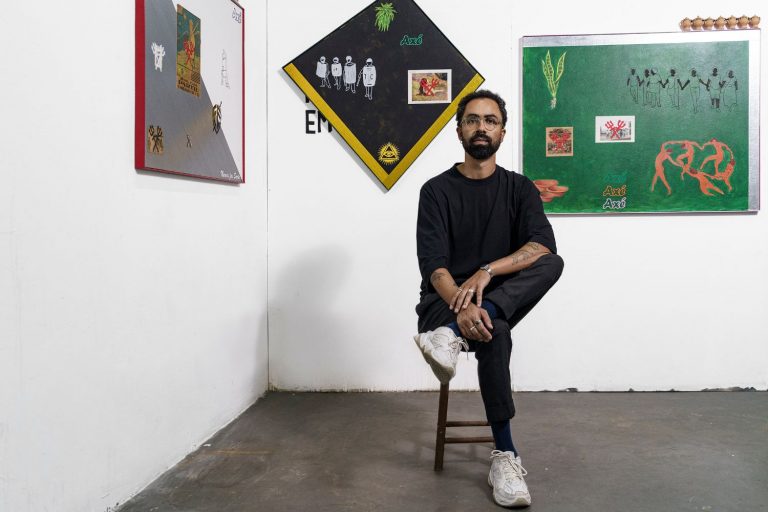
Perhaps it is the fact that Lauriano was born into a modest family in the historic year of 1985, when the end of the Brazilian military dictatorship was decreed, an executioner who curtailed our freedom for two long decades and a stain that even today stains the history of the country and the hearts of Brazilians.
After all, part of the population still believes that “there is no sin south of the equator”, as Chico Buarque‘s musical poetry has been singing and warning since 1973:
“There is no sin on the side below the equator
Let’s make a ripped, sweaty sin, full steam ahead
Let me be your slave, your doormat, your lover
A stream of love
When it’s a lesson in bashing, look out, get out from under
I’m a teacher.”
At the time of “Anos de Chumbo” (Years of Lead) (1968-1974), the great Chico’s song was acclaimed by those who knew how to read between the lines but, thankfully, not because of the censorship boorishness, in the clear and irreverent reference that his lyrics make to the colonial period.
An equator separating the good world from the bad, virtue (the Europeans) and vice (we, here, the mixed race) in a paradise where everything is (still) allowed for a few, and that this artist’s attentive eye, versatile in techniques and procedures, detects, denounces and tames in videos, installations, objects, texts, embroidery, plaques, and serigraphs.
In these incursions as an artist-historian, which also include themes such as police violence, labor exploitation, militarism, and land disputes, in innovative plastic language, he often uses the white “pemba” to map his investigations.
(The pemba is a conical-shaped white chalk used to transcribe messages from spirits and guides in Umbanda and Candomblé rituals).
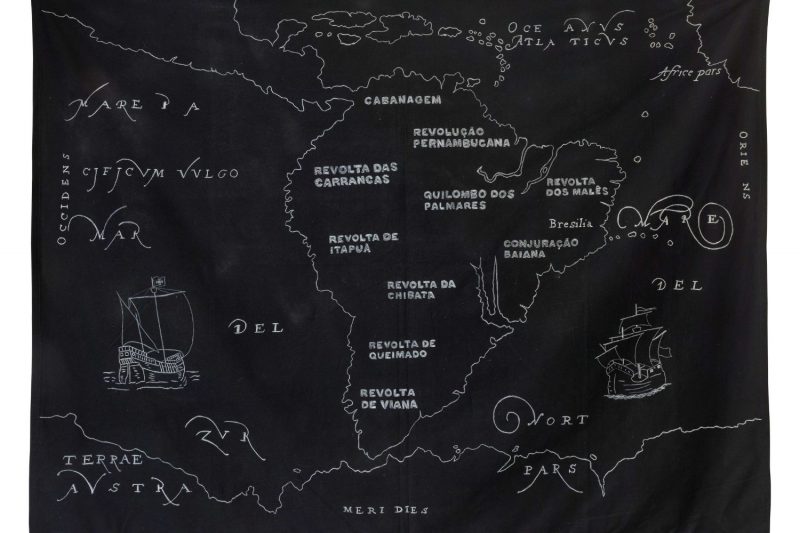
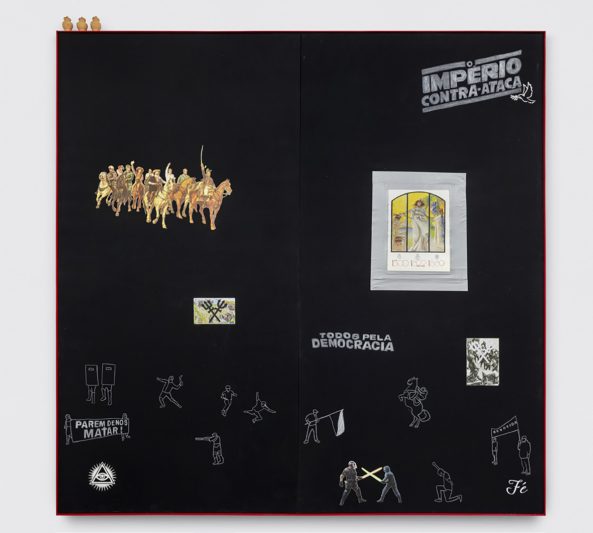
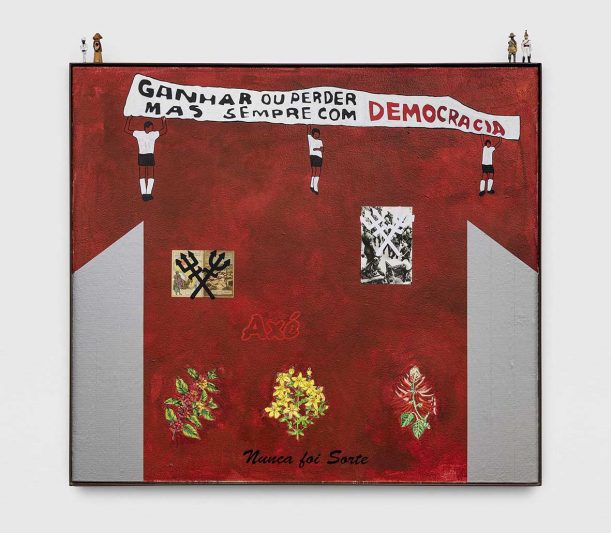
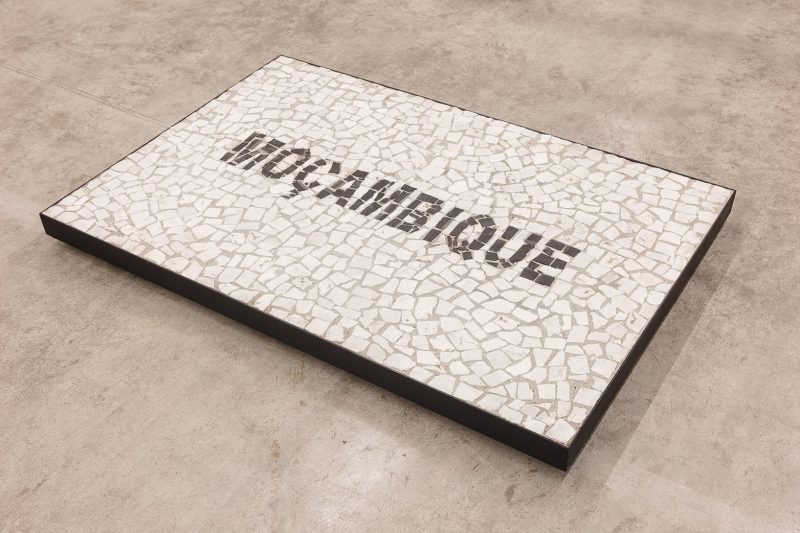
The talented Lauriano’s research also delves into the myths and symbols of our society, highlighting structures from the past that, since colonial Brazil, have mainly curtailed individuals from racial minorities.
He explains his obsession for this giant, indomitable, indecipherable that is the land where we were born.
“Since I realized that I would like to understand Brazil as a subject nation, (…) I focused on understanding how this subject, Brazil, produced these images.”
“However, since it was necessary to focus my research even more, I determined the period of slavery, post-slavery, and the Brazilian military dictatorship, as key moments to understand how the images produced by Brazil affected the construction of Brazilian society.”
Moacir dos Anjos, a researcher from Pernambuco and curator of the 29th São Paulo Biennial (2010), summarizes Lauriano’s reasoning.
“The artist indicates how the marks of Brazil’s racist past intrude on the history now unfolding in the country.”
This narrative is skillfully transmuted into revealing mappings of the construction of Brazil’s anthropophagic soul and our tropicalist psyche.
Or, as Caetano’s sensibility once put it, “always newly discovered and always a hidden island, Brazil.”
Lauriano has presented works at the 37th Panorama of Brazilian Art, São Paulo (2022), and the 11th Mercosul Biennial, Porto Alegre (2018).
Among the group shows he has participated in are:
- Histórias brasileiras (Brazilian Histories), at MASP (2022), which toured abroad under the title Afro- Atlantic Histories,
- the National Gallery of Art in Washington, DC,
- the Museum of Fine Arts (MFAH) (2022), in Houston, Texas, a museum with the largest collection of Latin American art.
The artist has works in collections such as:
- Fundação Joaquim Nabuco (Fundaj), Recife;
- Museu de Arte do Rio (MAR), Rio de Janeiro;
- in São Paulo at MASP and Pinacoteca do Estado de São Paulo,
- and at the Schoepflin Stiftung Foundation, Germany.
Service:
Jaime Lauriano – Here is the end of the world
April 29 to October 1, 2023
Rio Museum of Art – MAR, Rio de Janeiro
*With the collaboration of Cynthia Garcia, art historian [email protected].
**Nara Roesler founded Galeria Nara Roesler in 1989. With the partnership of her sons Alexandre and Daniel, the gallery in São Paulo, one of the most expressive in the market, expanded its operations, opening in Rio de Janeiro in 2014 and the following year in New York.
[email protected]
Instagram galerianararoesler
http://www.nararoesler.com.br/
With information from Forbes

